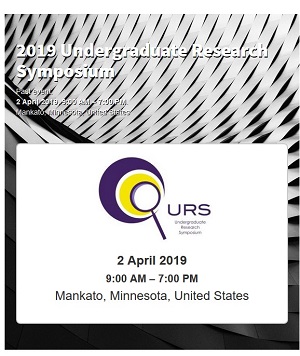Visualization of the Vasculature and Aqueous Fluid Outflow Pathway in Porcine Eyes
Location
CSU Ballroom
Start Date
2-4-2019 10:00 AM
End Date
2-4-2019 11:30 AM
Student's Major
Biological Sciences
Student's College
Science, Engineering and Technology
Mentor's Name
Michael Bentley
Mentor's Department
Biological Sciences
Mentor's College
Science, Engineering and Technology
Description
Glaucoma affects more than seventy million people globally. Glaucoma is caused by the buildup of aqueous fluid in the anterior chamber of the eye, which increases the pressure and causes optic nerve damage. A common form of the condition, open-angle glaucoma, is thought to be caused by a blockage of the aqueous fluid outflow pathway that allows fluid of the anterior chamber to drain into venous circulation. When leaving the aqueous chamber, the fluid travels through a complex network of blood vessels in the area of sclera surrounding the iris. However, these blood vessels are difficult to visualize because of the dense connective tissue. In this project, methylene blue dye and or tomato lectin, from Lycopersicon esculentum, conjugated with a fluorescent dye is perfused into the vasculature of the porcine eye via the anterior chamber. The fluorescent-labeled lectin is specific for vascular proteins, which allows the visualization of the vessels in the aqueous fluid outflow pathway. The tissue is cleared in DPX and examined with a laser confocal microscope, which provides a means to determine the three-dimensional architecture of the fluorescent-labeled vasculature. The information obtained from this visualization technique can be used in future glaucoma-related research.
Visualization of the Vasculature and Aqueous Fluid Outflow Pathway in Porcine Eyes
CSU Ballroom
Glaucoma affects more than seventy million people globally. Glaucoma is caused by the buildup of aqueous fluid in the anterior chamber of the eye, which increases the pressure and causes optic nerve damage. A common form of the condition, open-angle glaucoma, is thought to be caused by a blockage of the aqueous fluid outflow pathway that allows fluid of the anterior chamber to drain into venous circulation. When leaving the aqueous chamber, the fluid travels through a complex network of blood vessels in the area of sclera surrounding the iris. However, these blood vessels are difficult to visualize because of the dense connective tissue. In this project, methylene blue dye and or tomato lectin, from Lycopersicon esculentum, conjugated with a fluorescent dye is perfused into the vasculature of the porcine eye via the anterior chamber. The fluorescent-labeled lectin is specific for vascular proteins, which allows the visualization of the vessels in the aqueous fluid outflow pathway. The tissue is cleared in DPX and examined with a laser confocal microscope, which provides a means to determine the three-dimensional architecture of the fluorescent-labeled vasculature. The information obtained from this visualization technique can be used in future glaucoma-related research.
Recommended Citation
Murphy, Hannah; Keshari Sudasinghe; and Casey Schneider. "Visualization of the Vasculature and Aqueous Fluid Outflow Pathway in Porcine Eyes." Undergraduate Research Symposium, Mankato, MN, April 2, 2019.
https://cornerstone.lib.mnsu.edu/urs/2019/poster-session-A/34



